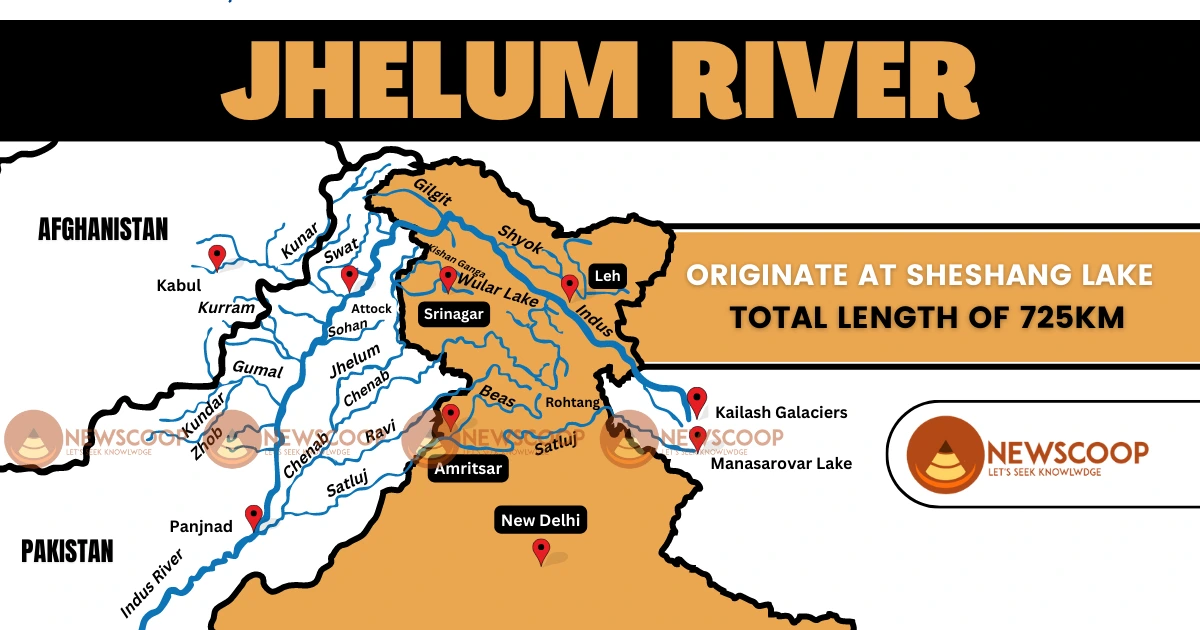Jhelum River System: Map & Origin | Dams
Welcome, UPSC aspirants! As you embark on your journey to conquer the Civil Services Examination, we bring you a comprehensive guide to understanding the Jhelum River and its significance in the context of your UPSC preparation.
The Jhelum River, with its rich history and geographical relevance, holds essential knowledge for acing your exams. Let’s delve into the depths of this enchanting river and discover its hidden treasures.
Geographical Features of Jhelum River
The Jhelum River, with its fascinating geographical features, flows through the picturesque landscapes of the Indian subcontinent. Here are some key geographical aspects of the Jhelum River:
- Origin: Jhelum River rises from Sheshang Lake near Verinag in Jammu and Kashmir, India.
- Course: Flows through the Kashmir Valley, enters Pakistan, and joins the Chenab River.
- Length: Approximately 725 kilometers (450 miles).
- Drainage Area: Covers parts of Indian-administered Jammu and Kashmir and Punjab, Pakistan.
- Topography: Meanders through valleys, mountains, and fertile plains.
- Tributaries: Receives water from Lidder, Neelum, Kunhar rivers, and others.
- Irrigation: Important for agriculture, supporting irrigation in the regions it flows through.
- Hydropower Potential: Utilized for hydropower generation through dams and barrages.
- Transboundary River: Flows through both India and Pakistan, requiring cross-border cooperation.
Dams on the Jhelum River
Here are some of the major dams on the Jhelum River:
- Uri Dam – Jammu & Kashmir
- Tulbul Project – Jammu & Kashmir
- Mangla Dam – Jammu & Kashmir
Significance
The Jhelum River holds immense significance in various aspects, making it a vital subject of study for UPSC aspirants. Some of its key importance include:
- Historical and Cultural Significance: The Jhelum River has been a witness to the rise and fall of ancient civilizations in the Indian subcontinent. Its banks are adorned with historical monuments, forts, and temples, reflecting the rich cultural heritage of the region. Studying its historical importance provides valuable insights into the past, art, and architecture.
- Water Resource and Irrigation: The river plays a crucial role in supporting agriculture in the regions it flows through. Farmers rely on its waters for irrigation, ensuring the fertility of the surrounding lands and sustaining agricultural practices.
- Hydropower Generation: The Jhelum River’s flow is harnessed to generate hydropower. Dams and barrages built along its course contribute significantly to the power generation capacity of both India and Pakistan.
- Transboundary River: Being a transboundary river, flowing through both Indian-administered Jammu and Kashmir and Pakistan, the Jhelum requires cooperation and agreements between the two countries for efficient water resource utilization. Understanding its management complexities is essential in the context of international relations.
- Ecological Balance: The River and its ecosystem support a variety of flora and fauna. Preserving its environmental health is vital for maintaining ecological balance and the well-being of local communities that depend on the river for their livelihoods.
- Trade and Commerce: Historically, it served as a prominent trade route between the Indian subcontinent and Central Asia. Even today, it facilitates trade and commerce along its course, contributing to regional economic development.
- Tourism and Recreation: The picturesque landscapes and historical sites along the Jhelum River attract tourists and provide recreational opportunities. This further boosts the region’s economy and cultural exchange.
- Flood Control: The construction of dams and barrages on the Jhelum River helps in flood control and managing water flow during monsoon seasons, protecting nearby areas from flooding.
Conclusion
In short, the Jhelum River holds historical, cultural, and environmental significance. It supports agriculture and hydropower generation, fosters international cooperation, and emphasizes the need for sustainable practices.
Understanding its multidimensional importance is crucial for UPSC aspirants in tackling diverse issues and policymaking.
Thank You!

